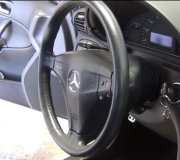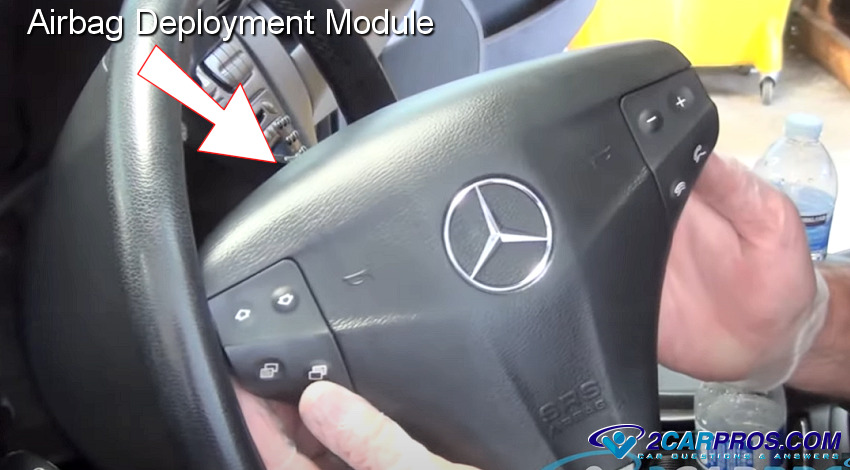Hi Richard. Welcome to the forum. The adjustment you are probably referring to is the pit-man shaft pre-load. It is the bolt and lock nut on top of the steering gearbox right in front. It sets the pressure on the pit-man shaft that comes out the bottom and turns the steering linkage. Chrysler used the same gearbox in the 1970's and 1980's. They had a lot of trouble with that getting out of adjustment on their trucks, but the same gearbox gave almost no trouble at all on rear-wheel-drive cars. GM really did not have much trouble on their trucks.
The place to start is by watching how far you have to turn the steering wheel before the tires start to turn. You should see wheel movement by the time you've turned the steering wheel two to three inches when the engine is running. There will be a lot more play when the engine is off because some of the play in the gearbox is taken up by pressurized power steering fluid.
Another approach is to crawl underneath and watch how the pit-man shaft responds when a helper moves the steering wheel back and forth a few inches a little faster than once per second. There are two things to watch. When the input shaft (steering wheel) turns, the output shaft, (pit-man shaft), should turn right away. If the pit-man shaft moves up and down just a little first, then starts to turn, that adjustment needs to be tightened a little. The procedure is rather involved, requires a torque wrench, and has never worked for me. Instead, I hold the adjustment screw in position while I loosen the lock nut so the initial setting will not be lost, then I carefully tighten the screw eighth turn, hold it there while tightening the lock nut, and drive it to see if it got better. If you over-tighten the screw you will find it miserable driving because it will bind when the steering wheel is straight ahead. You will have to constantly hold the steering wheel straight to keep it from bouncing to either side.
If there is no up and down movement in the shaft, watch very closely right next to where it exits the housing to see if it is moving sideways just a tiny little bit. This can be hard to determine because it is hard to differentiate between normal rotation and sideways movement. When the bushing wears out, the shaft will move sideways first when you turn the steering wheel, then once it bottoms out it will start to turn. It is much easier to do that than to tug on the steering linkage. As the bushing continues to wear from the hammering action of hitting bumps and potholes, the shaft will move sideways enough to move away from the lip seal and a fluid leak will result. To find either of these clues you will need the vehicle's weight on the tires, not jacked up off the ground. A mechanic will not see that movement during an inspection unless the truck is on a drive-on hoist and he knows what to look for. An additional clue to the worn bushing is it will cause steering wander. That is where you have to constantly keep moving the steering wheel to correct the truck's direction while you are trying to go straight. It is greatly affected by the slope, (road crown) of the road. Roads lean to the right for rain to run off, but they level out when you cross an intersection or there are bumps. Those things will make the truck momentarily wander to the left.
If you do not see anything unusual with the shaft in the gearbox, look for any steering component that is not moving as soon as the linkages move. Watch for movement between the balls and sockets of the four tie rod ends. Worn ones can usually be spotted during a routine inspection by grasping the front and rear of a tire and trying to turn it left and right. Looseness will be felt as a clunking feeling. At that point you have to watch them to see which one is worn.
The last thing to look at is what holds the front axle from moving sideways. Your truck should have upper and lower control arms and the differential is bolted right to the frame. That system is not particularly strong but spindle movement is not a common problem. About the only thing that can happen is worn control arm bushings and worn ball joints. Bushings are often overlooked during an inspection, (because they do not cause a lot of trouble), and ball joints are typically the first things checked, and worn ones are easy to spot.
Many older trucks used leaf springs on the front. That was typical of four-wheel-drive Dodges. Those trucks rode very rough but besides being really tough, a big advantage was those springs held the axle in place. No other linkages or bracing were needed. The newer ones use coil springs now for a real smooth ride, but they still use the solid axle housing for strength. That means there is a link that goes between the axle and frame to keep the axle from moving sideways. When that movement occurs, since the steering linkage is not moving too, the relationship between them changes causing the wheels to turn. That causes a lot of steering wander.
With the mileage listed, chances are you have had the truck aligned at least once. There are four adjustments on the two upper control arms that are not particularly strong so GM welds in plates to prevent them from slipping. To make alignment adjustments later a special "knockout" tool is used to elongate the mounting holes so the arms can be moved around. By your description, I do not think one of these are loose and moving but they should be checked to be sure they are tight. It is important to reach over the tire to tighten those nuts only when the truck is sitting on the tires and at normal ride height. You can check the nuts for tightness with the truck jacked up, but one that is loose, including when loosened during an alignment, must be tightened at normal ride height. When the truck is raised up, the control arm hangs down and its bushings turn. If it is tightened that way, the bushing will be in a permanent twist when the truck is lowered off the jack. That can lead to accelerated wear of the bushing.
One more thought. It is getting colder outside and that will cause tire pressures to drop. When tires are low the sidewalls will flex too much and cause a mushy steering feeling.
Caradiodoc
Thursday, November 4th, 2010 AT 4:33 AM


